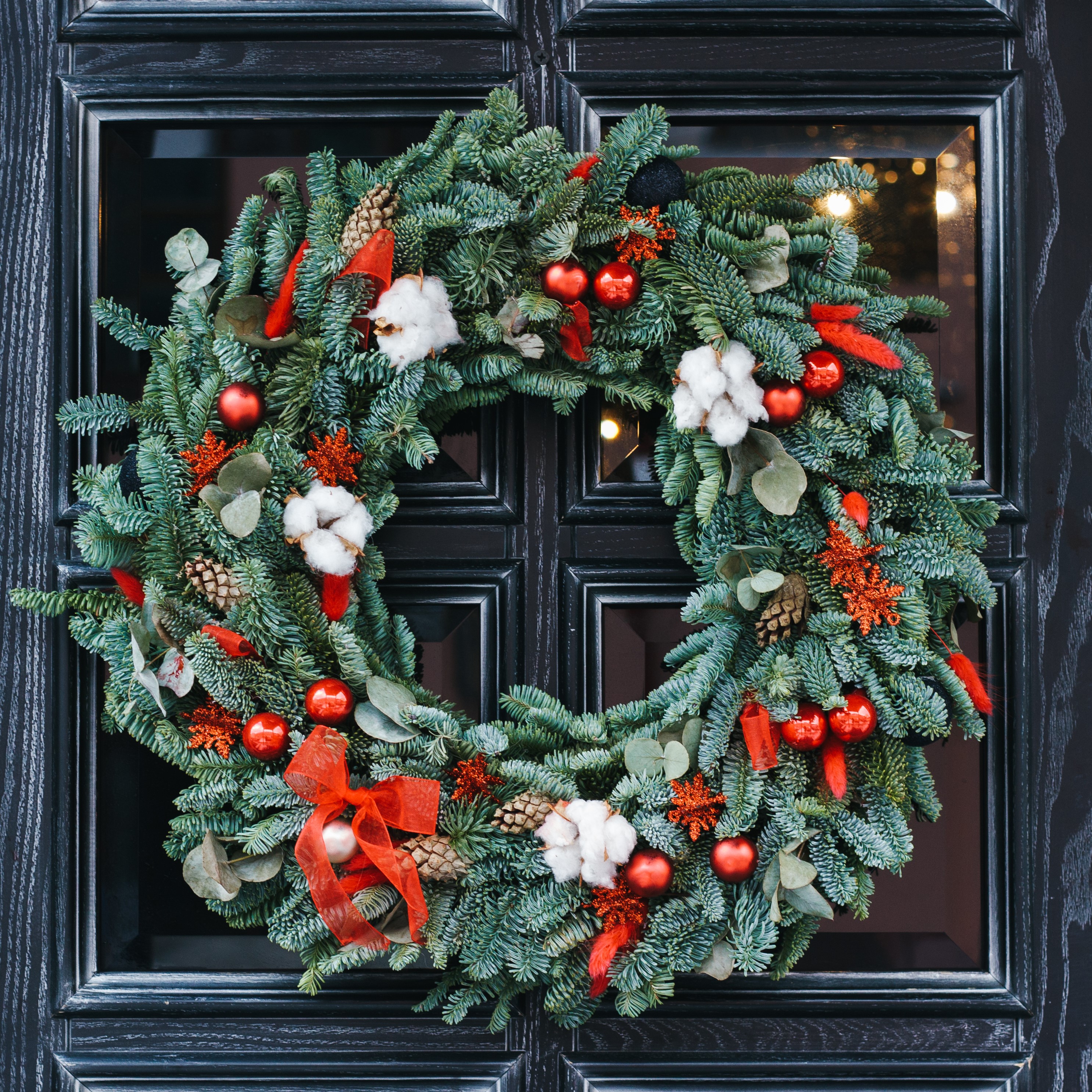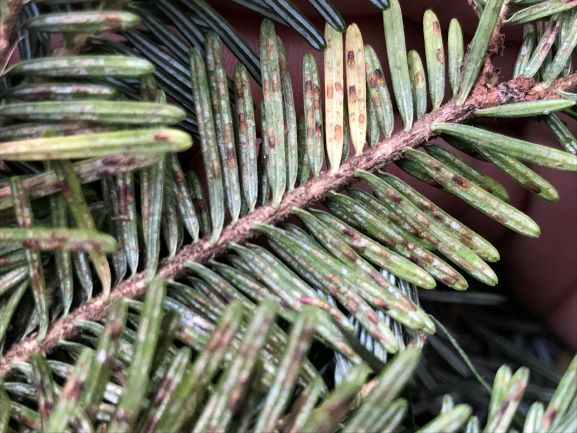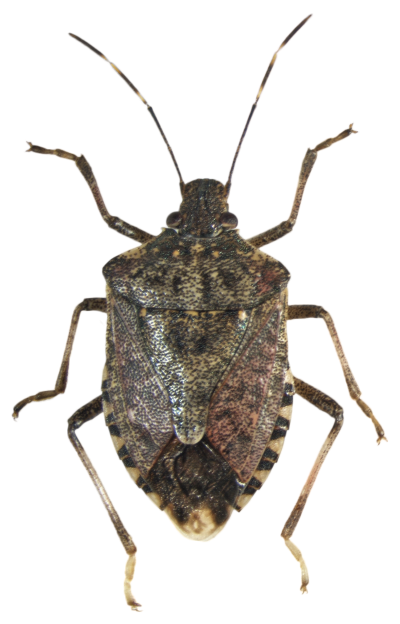 Many agricultural products from other parts of the country come into Minnesota during the holiday season. Examples of these products include: Christmas trees, wreaths, boughs, cut vines, shrubs, and plants with colorful fruits and seeds.
Many agricultural products from other parts of the country come into Minnesota during the holiday season. Examples of these products include: Christmas trees, wreaths, boughs, cut vines, shrubs, and plants with colorful fruits and seeds.
In preparation for the holiday season, the Minnesota Department of Agriculture (MDA) inspects material coming into our state to look for unwanted hitchhikers. Examples of pests moved through this pathway include: elongate hemlock scale, boxwood blight, round leaf bittersweet, spongy moth, brown marmorated stink bug, spotted lantern fly, and Japanese maple scale.
Means of Spread
There are many ways invasive insects, pathogens, and weeds can spread through holiday greenery and Christmas trees. The top three ways of spread are:
- Improper disposal of holiday greenery and Christmas trees.
- Moving firewood and wood products.
- Transporting in freight, on vehicles, and on recreational equipment.
How Can You Help?
- Buying locally grown holiday greenery is the easiest way to avoid spreading invasive pests that could be transported on greenery from out of state.
- The best option is to use a curbside tree collection or bring to a designated drop-off site. Check with your waste hauler, city, or county to see what services are offered in your area. The Minnesota Pollution Control Agency has a map of yard waste compost locations, contact locations directly to see if they accept trees and greenery.
- Do not toss trees and greenery into backyard woods or your residential compost pile, which will propagate the infestation.
- Wreaths and other decorative greens can be disposed in trash cans.
- If your city or county does not have an organized pick-up or drop-off, the last resort would be to burn the greens. Always check fire danger conditions and burning restrictions before burning and follow local ordinances.
At Risk
Products sold for the holiday season in North America have the broad potential to introduce pests that can affect our native plant communities and agricultural commodities. New infestations get started through the movement of this material across the country. The economic and environmental impacts they inflict can be serious if left unchecked.
Species
Insects and diseases can hitchhike on trees and holiday greenery. Boxwood blight and round leaf bittersweet could be found in holiday greenery and centerpieces. Spongy moth and elongate hemlock scale are typically moved around on Christmas trees and wreaths. Click on the species below to learn more about them.
Holiday Greenery Invasive Insects
Elongate hemlock scale is found almost exclusively on the underside of conifer needles. Given their small size and inconspicuous appearance, the elongate hemlock scale may appear to be dirt or debris to the untrained eye. Elongate hemlock scale has a host range up to 40 species of conifers and prefers: hemlock, fir, and spruce. It has been detected in Minnesota but not in landscape or natural areas. They can be found hitchhiking on:
- Christmas trees
- Holiday wreaths, bows, and sprays
- Nursery stock
Elongate Hemlock Scale Distribution
Elongate Hemlock Scale Biology

- Christmas trees
- Nursery stock
- Logs
- Firewood
- Recreation equipment, including campers, and lawn chairs
Spotted lanternfly is a primary pest of vineyards and nursery stock, with a host range up to 65 plant species. It has not been found in Minnesota. It can be found clinging to most anything including:
- Christmas trees
- Plants
- Smooth building materials like bricks, stone, and metal
- Vehicles, trailers, and freight
A major pest of fruit trees and vegetables with a wide range of host plants, BMSB overwinters by invading and hitchhiking on manufactured items. It is established in parts of Minnesota. They are adept at stowing away on:
- Holiday greenery freight
- Cargo containers
- Vehicles
- Recreation vehicles
Brown Marmorated Stink Bug Distribution
Brown Marmorated Stink Bug Biology

Japanese maple scale has a large host range of mostly trees and shrubs. It has not been found in Minnesota. It can be found hitchhiking on:
- Holiday twigs and sprays of shrubs like dogwood and willow
- Nursery stock
Japanese maple scale is widely distributed throughout the eastern United States.
Holiday Greenery Invasive Pathogens
Holiday wreaths, garlands, and planters often contain shoots from boxwood plants. Boxwood is an evergreen shrub with dark green, round leaves. Boxwood blight is caused by the invasive fungus Calonectria pseudonaviculata. This disease causes leaf spots, stem lesions, and leaf drop in boxwoods. It can spread fast in the landscape, killing nearly all plants affected. It has not been found in Minnesota. This pathogen can:
- Overwinter in plant debris and discarded holiday décor
- Spread to the landscape causing complete collapse of boxwood plants
Boxwood blight is found in more than 25 states including Wisconsin.
Sudden oak death host material is potentially used in holiday décor. Host material includes: evergreen trees, bows, and decorative sprays used in holiday arrangements. Sudden oak death is regulated at the federal and state level with quarantines and has not been found in Minnesota. Common species potentially carrying sudden oak death include:
- Evergreen trees, bows, and decorative splays used in holiday arrangements.
- Fir, Abies
- Witch hazel, Hamamelis
- Rhododendron
- Sweet bay laurel
- Holly
- Magnolia
- Scotch heather
- European beech
- Shallon, or Gaultheria shallon
Holiday Greenery Invasive Weeds
Round leaf bittersweet vines have been used in holiday decorations and other crafting items for many years. Fruiting branches, which have red berries and yellow fruit capsules, make wreaths charming but easily spreads seeds. Round leaf bittersweet is a vine that strangles trees as it grows up the tree canopy. It can choke out other woody plants and can take over a forest canopy. It is established in parts of Minnesota and is designated as Prohibited Eradicate on the Minnesota Noxious Weed List. If craft arrangements, such as wreaths, are placed outside, birds can eat the fruit and move the seed to new locations. It can also spread by:
- Discarded holiday wreaths, bows, and decorations
- Nursery stock
- Birds
- Other mammals
Round leaf Bittersweet Distribution
Round leaf Bittersweet Biology
Multiflora rose is a noxious weed of many states because of it's invasive tendencies. It has been found in Minnesota and is listed as Restricted on the Minnesota Noxious Weed List. It can be spread in:
- Holiday wreaths
- Holiday décor


